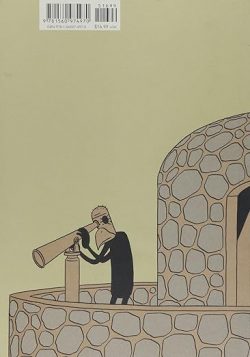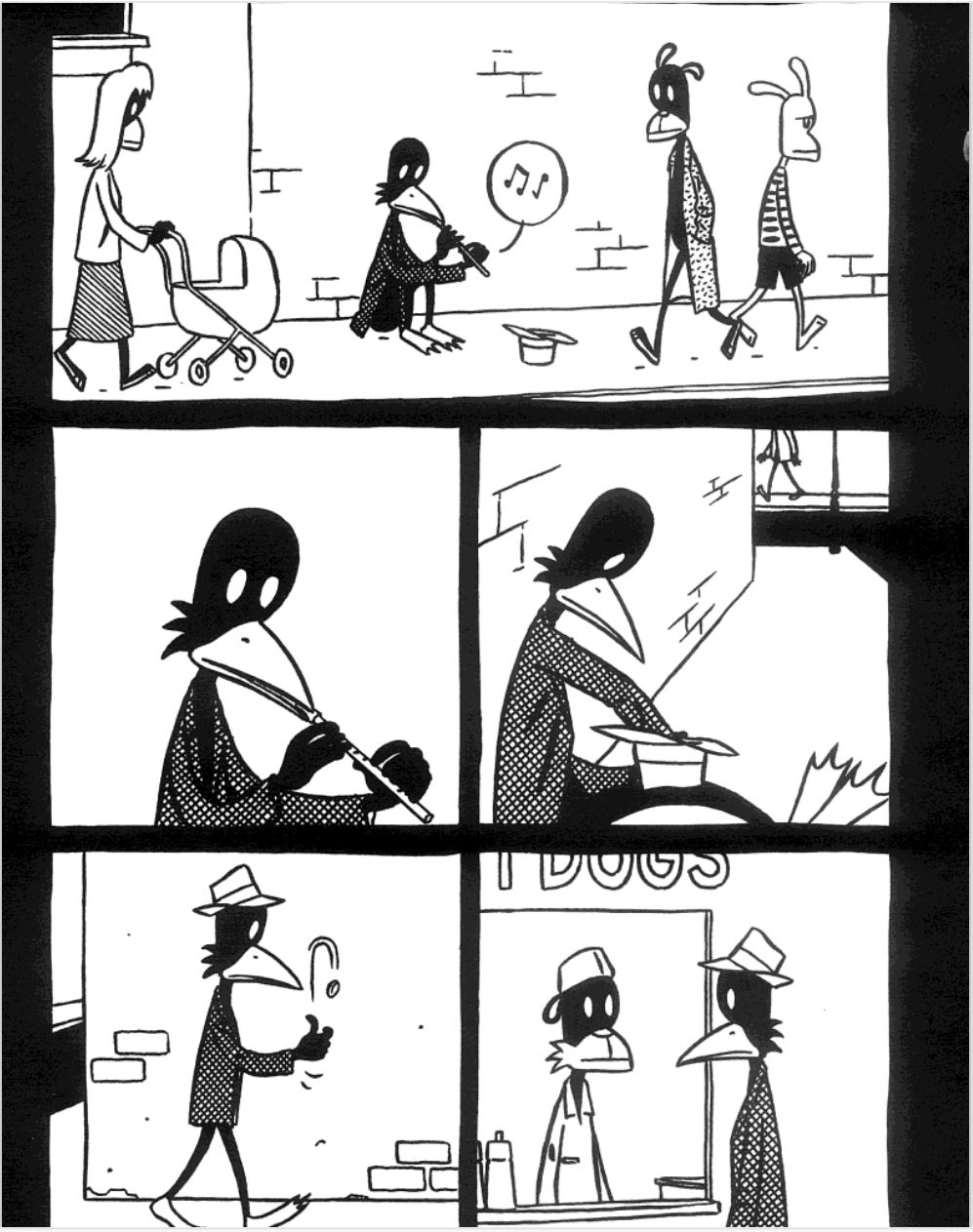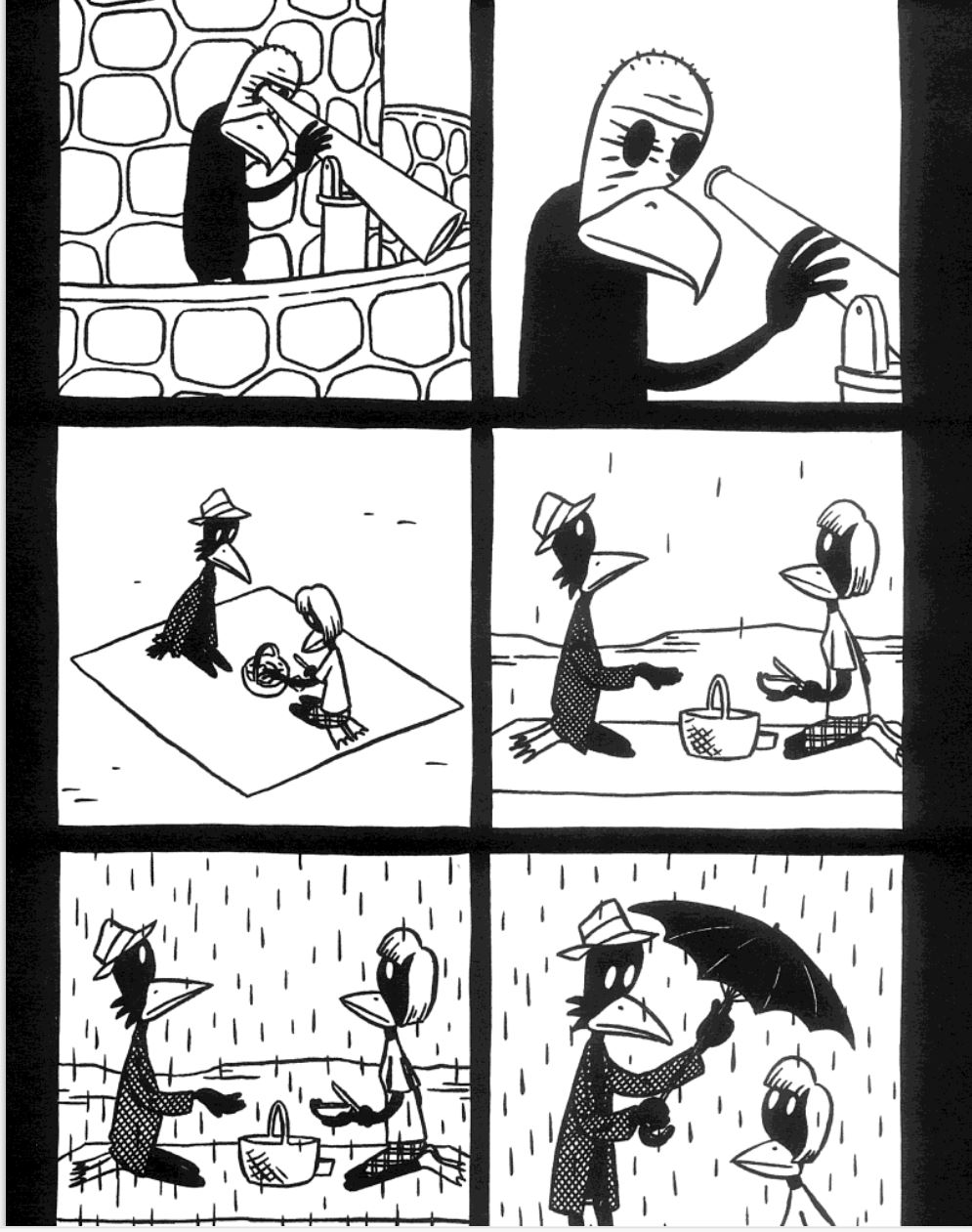
By Reed Waller & Kate Worley with James M. Vance (NBM/Amerotic)
Set I ISBN: 978-1-56163-601-3
Vol. 1 ISBN: 978-1-56163-451-4, vol. 2 ISBN: 978-1-56163-457-3, vol. 3 ISBN: 978-1-56163-474-3
Set II ISBN: 978-1-56163-601-3
Vol. 4 ISBN: 978-1-56163-451-4, vol. 5 ISBN: 978-1-56163-451-4, vol. 6 ISBN: 978-1-56163-451-4, vol. 7 ISBN: 978-1-56163-451-4
This book includes Discriminatory Content produced for dramatic and satirical effect.
Just for a change I thought I’d celebrate an astounding creator while they’re still alive, and morbid leanings aside, in a world both wide and awash with unique stylists, I can honestly say there has never been anyone like Reed Waller (born today in 1949)…
And in case the covers didn’t give it away…
These books are intended to make adults laugh and think and occasionally feel frisky. If the cover images haven’t clued you in, please be warned that these items contain nudity, images of sexual intimacy – both hetero and homosexual – and language commonly used in the privacy of the bedroom and school playgrounds whenever supervising adults aren’t present. If that sort of thing offends you, read no further and don’t get these books. The rest of us will enjoy one of the best graphic novel experiences ever created without you.
Omaha the Cat Dancer began during the 1970s as an “Underground” venture and over torturous decades grew into a brilliant but controversial drama of human fallibility with all the characters played by funny animals. What most people noticed was a matter-of-fact, constant inclusion of graphic sex acts. Over the years, the series was subject to many obscenity seizures by various muddle-headed stickybeaks, inspiring the formation of the Comic Book Legal Defense Fund. One classic case apparently involved the local defenders of morality raiding a comics store because Omaha promoted bestiality…
As there’s only so much excitement a man of my advanced years and proclivities can endure (and probably only so much me you can stand) I’ll review these in one hit, but if you can locate the whole saucy saga in its original supremely economical shrink-wrapped gift set, you’d be crazy to not take advantage of that but please, pace yourselves…
Following an introduction by late-coming co-scripter James Vance, and Reed Waller’s original intro from a1987 collected edition, The Complete Omaha the Cat Dancer Volume 1 gathers the short story appearances from a number of Counter-culture Commix as well as some out-of-continuity infilling short pieces so readers can enjoy what can best be described as the official Directors Cut of the tale.
The wicked wonderment begins with the very first ‘Adventures of Omaha’ from Vootie in 1978. Vootie started in 1976 as a self-published fanzine founded by Waller and like-minded artistic friends who bemoaned the loss of anthropomorphic comics – once a mainstay of US comicbooks. When contributors also griped that there wasn’t much sex in comics either, Waller, taking inspiration from R. Crumb’s Fritz the Cat and responding to recent intensification of local “Blue Laws”, created the evocative, erotic dancer and compared her free and easy lifestyle to a typical, un-elected, interfering know-it-all moral guardian busybody. Blue Laws were – and probably still are – particularly odious anti-fun statutes usually instigated by religious factions designed to keep the Sabbath holy by dictating shop-opening hours and generally limiting or banning adult entertainments like clubs and pubs (but not gun clubs!) and their repressive use (in fact and fiction) became a major narrative engine for the series.
‘Why they Call Her Omaha’ introduces young stripper Susie Jensen who hits the metropolis of Mipple City, Minnesota (a barely concealed Minneapolis) and signs up with a modelling agency where she meets fellow dancer Shelley Hine. Over lunch they bond and pick a better stage name for the gorgeous but naive newcomer, whilst ‘Kitten of the Month’ & ‘Omaha centrefold’ reveal the first glorious results of her management’s efforts. No-holds-barred sexual action returns in ‘Shelley and Omaha’ with the girls, now popular erotic dancers, meeting some guys who will play a big part in the unfolding drama to come.
In ‘Chuck and Omaha’, which officially heralded the beginning of scripter Kate Worley’s (16th March, 1958 – 6th June, 2004) stunning and crucial contribution to the series, Jerry – one of those aforementioned pick-up guys – introduces Omaha to Chuck Katt, a shy artist who will become the great love of her life. ‘Adventures of Omaha’ sees a budding relationship progress whilst ‘Tip of the Iceberg’ moves the grander story arc along when Mipple bans nipples in the opening shot of a political power-grab using Christian/Family-morality pressure groups as unwitting, if fervent, patsies…
Although comprising less than 50 pages, all that material took nearly 15 years to produce. For the longest time, Omaha had no fixed abode; peripatetically wandering from magazine to Indie book, and even guest-shots in the occasional mainstream publication. From Kitchen Sink’s Bizarre Sex #9-10 in 1981-2; a pastiche page in E-Man (1983 and included in vol. 2); Dope Comix #5 (1984), she even starred in a story from Munden’s Bar Annual #2 in 1991. Often stalled for creative, when not censorship, reasons Omaha finally won her own title in 1984 thanks to SteelDragon Press, before vanishing again until 1986, when Kitchen Sink Press took over publication. For further details I strongly advise CAUTIOUSLY checking the internet…
Volume 1 switches to high gear and addictive narrative mode with ‘Omaha #0’: a single page recap followed by a powerfully compelling yarn wherein forces of decency make life difficult for the adult entertainment industry. With stripper bars closing, Omaha is recruited to dance for “The Underground”: an exclusive, ultra-secret, high-class bordello catering to the darkest desires of America’s ultra-elite of businessmen and politicians… many of whom are actively leading the Decency campaign. Shelley is involved too, recruiting contacts from her old profession for more hands-on roles. Chuck meanwhile has reapplied for his old advertising job where old girlfriend Joanne makes life uncomfortable. She has other problems too, as powerful forces draw Omaha & Chuck into a far-reaching, sinister scheme…
On opening night all elements for disaster converge as the Movers and Shakers get more debauchery than even they can handle as someone dopes the entire proceedings, leading to a violent, destructive orgy that previously set up cameras record for blackmail purposes. As they flee the club, hitmen try to kill Chuck but shoot Shelley instead. Believing her dead, Omaha & Chuck run for their lives. Heading for Joanne’s house, Chuck reveals he is the son of Charles Tabey: monomaniacal millionaire businessman, undisputed ruler of Mipple City and the probable true target of the assassination…
Narrowly escaping another murder attempt, they find Tabey and Joanne are intimately involved, and are horrified to find Chuck’s pa was behind the whole thing, intending to mould the wastrel into the kind of son he needs. The sire is also clearly stark, raving mad…
Traumatised and terrified, the young lovers jump into their car and head for California in the short ‘Adventures of Omaha’ quickie with the initial volume concluding with the contents of ‘Omaha #1’ as they reach San Francisco tired, hungry and broke. Grateful for the kindness of strangers, they soon discover Joanne waiting for them and find that Tabey is not their only persecutor. During a drunken three-way another hired killer almost ends them all. From a well-intentioned, joyous celebration of open living free-loving modernity Omaha had evolved into a captivating adult soap opera and conspiracy thriller of mesmerising intensity and complexity…


With an introduction by Worley, Volume 2 eases into the enticing adult entertainment with a ‘Hotziss Twonkies’ parody from E-Man #5 prior to Omaha #2-5 enlarging the saga. In the aftermath of another close shave, Chuck & Joanne bitterly spar whilst an increasingly traumatised cat dancer wanders the streets of San Francisco. When Tabey abducts her whilst moving against all his old enemies, Chuck & Joanne fall into bed…
Meanwhile Jerry, who also works for Tabey, is busying sorting fallout from the club riot/shooting. In a secluded palatial beach-house Omaha discovers Chuck’s dad has been watching over them for some time and soon discovers another shocking secret…
Omaha was utterly groundbreaking in its mature treatment of gay and disabled relationships: offering the sound, common sense opinion that this is what all people think and do. After all, “it’s just sex”…
Paralysed but not deceased, Shelley is also sequestered in the house. She is a long-term Tabey employee and slowly developing a relationship with her nurse Kurt Huddle, and the manic tycoon has convinced Omaha to stay and help care for her. Back in ’Frisco, Chuck rekindles his old relationship with Joanne, utterly unaware she has film and photos taken at the club on that terrible night. That’s where gay photographer and old friend of Joanne Rob Shaw enters the picture as developer and guardian of the contentious materials…
Chuck misses Omaha and tension leads to his splitting with Joanne and moving in with Rob. The cat dancer too is lonely, finding brief and unsatisfactory solace with Jerry again, so when Tabey goes off his meds Jerry arranges for Chuck & Omaha’s reunion, leading to a dreadful confrontation between father and long-estranged son, the apparent result of which is Tabey taking his own life…
Together again after so long, Omaha & Chuck comfort each other as repercussions of Charles Tabey Sr.’s demise shake the country and the cast. The close-knit group endure loss, guilt and outrageous press scrutiny as the matter of inheritance crops up. Against his wishes, Chuck might be incredibly rich and saddled with unwanted responsibilities, but there are some unspecified problems with the will. The plots thicken when Joanne and Rob have a falling out and as all this is going on, back in Mipple City, a powerful new threat makes his move. Senator Calvin Bonner was one of the patrons at the Underground that fateful night, but now he’s making his move for total power, stirring up a wave of fundamentalist hatred and anti-smut indignation with his “Crusade for Decency”…
Covering issues #6-9, and with an introduction by Trina Robbins, Volume 3 follows the action back to Minnesota, but things are difficult for Chuck & Omaha – who can’t seem to re-establish that earlier, innocent rapport. As they go house-hunting, in San Francisco Rob Shaw is visited by thugs after the photos of The Underground riot. His shop destroyed, the photographer narrowly escapes burning in it…
Mipple City’s Blue Laws are more draconian than ever. When Omaha and Shelley – who has moved into the ground floor of the Cat Dancer’s new house – visit old workplace the Kitty Korner, and discover performers must now dance behind plate glass… which makes taking punter’s tips really tricky…
When old friend Shawn turns up, he warns Chuck & Omaha of the plan to redevelop A Block – the part of town where all the artists, musicians and strip clubs are. Something needs to be done to stop it and now Chuck might just be the richest, most influential degenerate in town…
As the lovers go furniture shopping, Shelley and Kurt look for a suitable physical therapy clinic – preferably a non-religious, non-judgemental un-condescending one – and later, whilst Omaha helps Shelley move in, Chuck and Jerry make plans to fight the A Block development. As ever, there is far more going on than the lovers can imagine…
Omaha wants to get back into dancing and, as Chuck becomes increasingly mired in running his father’s many businesses, Kurt learns (some) of Shelley’s murky history even as Joanne and Jerry compare notes and make plans. Rob turns up in Mipple after more attempts on his life, convinced he needs to find his attackers’ boss before his luck runs out. The book ends on a shocking note for Chuck when he discovers his long-dead mother isn’t…

The stunning, addictive saga of the erotic dancer, her bone-headed boyfriend and animalistic extended ensemble takes a dark and dreadful turn with Volume 4 – re-presenting the Kitchen Sink Omaha #10-13 (plus one-page gag strip ‘Alterations’ from Fire Sale #1, 1988-1989) – as the death of Charles Tabey Sr., increasing violence and oppression of the Campaign for Decency and a seemingly constant stream of personal revelations strain Omaha & Chuck’s relationship to the breaking point.
The story resumes after an introduction from writer James Vance who married Worley after her break-up with Waller. He then worked with the artist to finish the saga from her notes after her untimely death from cancer in 2004. Tense and suspenseful, the drama kicks into high gear as Chuck comes to terms with the shocking knowledge that his mother didn’t die decades ago.
The pressure seems to be affecting him badly – or perhaps the thought of all the wealth and responsibility – and our decent young rebel is becoming as exploitative, abusive and creepy as his manic dad ever was, but even though he’s acting paranoid, it doesn’t mean he’s hasn’t got real and deadly enemies…
The situation isn’t helped by learning that somewhere his beloved Omaha has a husband she hasn’t quite divorced and never ever mentioned…
Slyly sinister Senator Bonner is ratchetting up the pressure of his anti-smut campaign and even close ally Jerry is working to his own agenda, with the assistance of avaricious partner Althea. Confused, lonely and neglected, Omaha devotes her energies to dancing for the upcoming video for Shawn’s band, whilst Rob confronts Shelley – whom he believes ordered the attempt on his life and torching of his studio…
When Tabey’s will is read, Chuck does indeed inherit the bulk of his father’s holdings as well, apparently, as many of Tabey Sr.’s deranged obsessions. Far more intriguing than she seems, Shelley acts on Rob’s misperceived accusations whilst lover/carer Kurt finds part-time employment with mysterious Mr. Lopez – the last major player in an increasingly complex game. Meanwhile, high-powered call-girl, blackmailer and Keeper of Secrets Joanne re-insinuates herself with Jerry – and Chuck… and Bonner(!) in a terrifying confrontation that threatens to destroy Omaha and crush Chuck in his own blackmail scheme…
During the video shoot, Omaha & Joanne compare notes on Bonner, after which the capable callgirl enlists Rob’s aid in a scheme to get the goods on the hypocritical Senator, with whom she shares a highly secret and extremely specialised professional relationship. Sadly, whilst both Joanne and Rob practice their unique personal skills, the senator is murdered in the most compromising of all positions and the story moves effortlessly from passionate drama to dark murder mystery. Abandoned, bewildered, angry and very hurt, Omaha leaves town, unaware that both she and Joanne are suspects in the Bonner murder case…
As she heads for a new life in rural Wisconsin, Chuck relearns some long-forgotten personal history from his mother, but no matter how she disguises her appearance, an increasingly popular video means the cat dancer will never be truly safe or unseen…
Volume 5 is introduced by Neil Gaiman, after which issues #14-17 (1990-1992) find the lovers painfully adapting to life apart, with Omaha’s old friends wondering where she’s gone. Meanwhile in Lawrenceville, Wisconsin, after an abortive stab at office work for an all-too-typical, male-dominated factory, “Susan Johnson” goes back to honest work, dancing in the town’s only strip joint, making reliable new friends and meeting a young man who will become far more…
Back in Mipple, Joanne’s lawyer finally clears her of suspicion in Bonner’s demise, Jerry plans to reopen infamous bordello The Underground as a legitimate nightclub and Chuck is making new friends and intimate acquaintances whilst spending his days trying to save the Bohemian A Block district from redevelopment. However, he inadvertently gets far closer to the heart of all the various intrigues threatening the players in the drama, and Jerry’s business partner Althea reveals her true colours… and allies. At Bonner’s funeral, Lopez reveals an unsuspected connection to the venomous politician…
Shelley has made new friends too – in a scathing, utterly delightful episode exposing unexpected biases held by certain sorts of feminists and do-gooders. Joanne is increasingly at odds with Rob regarding films of Bonner’s last moments and when Jerry invites Chuck to become partner in his nightclub venture Althea seeks to secure the deal by offering herself as a sweetener… Or does she actually have another reason for her bold advances?
Kurt & Shelley’s relationship starts showing signs of strain, but in Lawrenceville Susan is relaxed and happy, with the strength to contact the friends she ran out on. In Mipple, the cops slowly uncover uncomfortable facts about everybody in the Bonner case when the Senator’s private secretary comes forward with new information, and Joanne secures the final weapon necessary to expedite her plans…

The final Kitchen Sink issues – #18-20 (1993-1994) – comprise the major part of Volume 6. Following an introduction from Terry Moore, there’s a brief discourse on the large cast’s other appearances, accompanied by short pieces from diverse places. First, there’s the delightful foray into mainstream comics culled from Munden’s Bar Annual #2 in 1991. ‘A Strip in Time’ sees the exotic kitty visit the legendary pan-dimensional hostelry after which come two short ‘n’ sexy vignettes originally produced for The Erotic Art of Reed Waller: one untitled and the other graced with the subtly informative designation ‘Waking Up Under a Tent’, to somewhat offset the angst and drama of the main event hoving into view…
Here, Rob learns what Shelley’s actual role was in the arson attack on his shop, Joanne takes a live-in position with Mr. Lopez and – after many abortive attempts – Chuck & Omaha finally speak. As Thanksgiving dawns, many of Omaha’s friends gather for a momentous dinner and things start to unravel for the bad guys trying to destroy A Block.
And, back in Wisconsin, just as she’s becoming reconciled with Chuck, her fling with appreciative punter Jack intensifies to a crisis point. Meanwhile elsewhere, someone with an intimate knowledge of her recognises the hot dancer in a rock video and begins making fevered inquiries…
When Shawn’s touring band reaches Lawrenceville and discover Susie is Omaha, the scene is set for her return to Mipple City, where – after being arrested in connection with Bonner’s murder – Chuck’s mother reveals the whole story of her past, the sordid truth of Bonner’s obsessive depravity and Charles Tabey’s bi-polar affliction. In light of horrific revelations, Chuck seems to go completely off the deep end and, far too late, his friends and family realise money and looks might not be the only things the son inherited from the father…
Next, just a smidge out of chronological order, comes ‘Tales of Mipple City: Rob Steps Out’: a charming first date sidebar tale from Gay Comics #22 (1994), after which revelations resume as the cops release Maria Elandos Tabey, and her boy is sectioned. In Lawrenceville, Susie gets an unforgettable farewell from before she returns to her true love… who has never needed her more…
The last volume in this magnificent sequence features the final four issues published by Fantagraphics as Omaha the Cat Dancer volume 2, #1-4 (1994-1995). The series at times seemed truly accursed: plagued by illness, delays and creative problems which took a cruel toll on all the creators. Waller & Worley ended their relationships in spectacular fashion at this time and only began working together again in 2002. Two years later Worley died from cancer and it seemed the saga was destined to remain an unfinished masterpiece, but in 2006 Waller and Worley’s husband James Vance began to finish the job from her notes, with the concluding chapters serialised in the magazine Sizzle. When those final instalments were finally collected the completed Omaha the Cat Dancer became a contender for possibly the finest adult comics tale in history*
Here and now, however, the compulsive obsessive yarn reaches a kind of conclusion as – after an introduction from honorary Mipple City citizen Denis Kitchen, and a stunning cartoon recap – Omaha & Chuck renew their relationship, Jerry & Shelley and Rob & Joanne reach workable détente agreements and that tantalising missing husband tracks the cat dancer to her new home. Set over Christmas and New Year’s period, various plot threads come together during an unforgettable party at Chuck’s palatial new house, although a hung-over aftermath promises there are still stories to be told and loose ends to be knotted off once and for all…
Even if the saga had stopped here, Omaha the Cat Dancer would be an incredible narrative achievement and groundbreaking landmark of comics creation, but with the promise of a final resolution still to come, it’s likely to become an icon of our industry, celebrated forever for moving beyond simple titillation and happy, innocent prurience to become a fully matured work of Art. Captivating, intense, deeply moving and addictively engrossing, Omaha never forgets to be also fun, funny, fabulous and utterly inclusive: full of astonishingly well drawn, folk (admittedly largely furry or feathered folk) happily naked and joyously guilt-free… at least about sex.
Monochrome tomes printed at 220 x 280mm (much larger than the original comic books), these books also contain copious full page illustrations – many taken from companion book The Erotic Art of Reed Waller. This saga is one of those true turning points in comics history – a moment we could all provably say “this is socially relevant, capital ‘A’ Art” – as viable and important as the best play or film or symphony: don’t miss any opportunity to make yourself familiar with the whole marvellous classic…
No cats, dogs, chickens, moose, ferrets or anything else living (well maybe some trees) were harmed, abused, distressed or disagreeably surprised in the making of these stories, so if you’re open-minded, fun-loving and ready for the perfect grown-up adventure please take advantage of this unmissable opportunity. You won’t regret it…
© 1978, 1981, 1982, 1984, 1985, 1986, 1987-1996 Reed Waller & Kate Worley. Contents of these editions © 2005-2007 NBM. All Rights Reserved. © 1987-1996 Reed Waller & Kate Worley. Contents of these editions © 2005-2008 NBM. All Rights Reserved.
*A slight footnote (pawnote?). That eighth volume was finally released in 2013, to complete the saga, and we’ll be tackling that in its own post and on its own merits in the fullness of time. Keep ’em peeled, folks…











































